| Strain Name |
C57BL/6-Pdcd1tm1(PDCD1)Bcgen Cd274tm1(CD274)Bcgen C5ar1tm1(C5AR1)Bcgen/Bcgen
|
Common Name | B-hPD-1/hPD-L1/hC5AR1 mice |
| Background | C57BL/6 | Catalog number | 131216 |
|
Related Genes |
PDCD1: CD279, PD-1, PD1, SLEB2, hPD-1, hPD-l, hSLE1; CD274: B7-H, B7H1, PD-L1, PDCD1L1, PDCD1LG1, PDL1, hPD-L1; C5AR1: C5A, C5AR, C5R1, CD88 |
||
|
NCBI Gene ID |
18566,60533,12273 | ||
Protein expression analysis
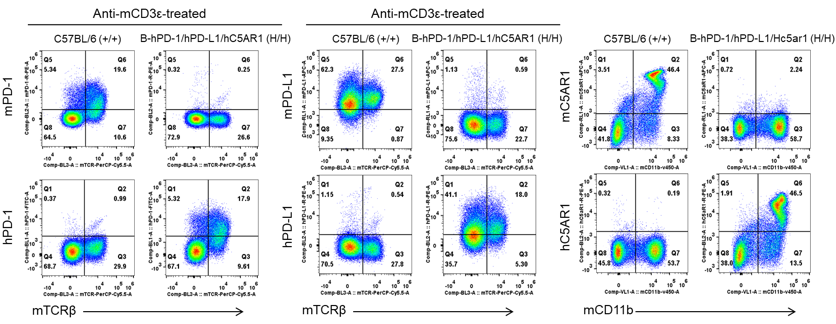

Analysis of spleen leukocyte subpopulations by FACS. Splenocytes were isolated from female C57BL/6 and B-hPD-1/hPD-L1/hC5AR1 mice (n=3, 6-week-old). Flow cytometry analysis of the splenocytes was performed to assess leukocyte subpopulations. A. Representative FACS plots. Single live cells were gated for the CD45+ population and used for further analysis as indicated here. B. Results of FACS analysis. Percent of T cells, B cells, NK cells, dendritic cells, granulocytes, monocytes and macrophages in homozygous B-hPD-1/hPD-L1/hC5AR1 mice were similar to those in the C57BL/6 mice, demonstrating that PD-1, PD-L1 and C5AR1 humanized does not change the overall development, differentiation or distribution of these cell types in spleen. Values are expressed as mean ± SEM.
Analysis of T cell subpopulation in spleen
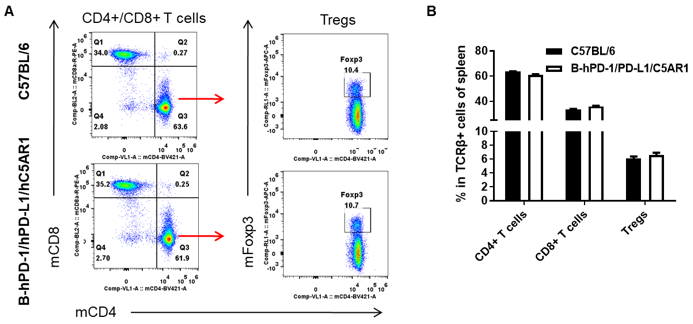
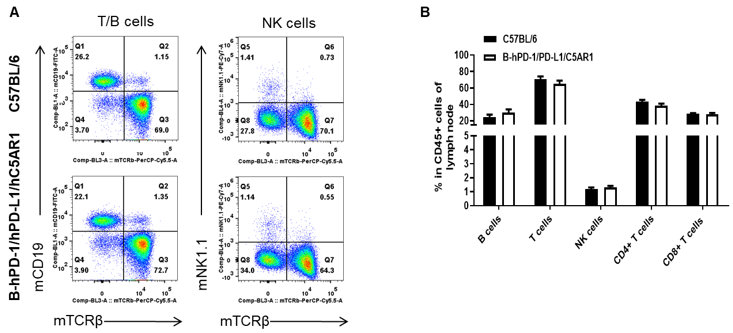
Analysis of lymph node leukocyte subpopulations by FACS. Lymph nodes were isolated from female C57BL/6 and B-hPD-1/hPD-L1/hC5AR1 mice (n=3, 6-week-old). Flow cytometry analysis of the splenocytes was performed to assess leukocyte subpopulations. A. Representative FACS plots. Single live cells were gated for the CD45+ population and used for further analysis as indicated here. B. Results of FACS analysis. Percent of T cells, B cells, NK cells, dendritic cells, granulocytes, monocytes and macrophages in homozygous B-hPD-1/hPD-L1/hC5AR1 mice were similar to those in the C57BL/6 mice, demonstrating that PD-1, PD-L1 and C5AR1 humanized does not change the overall development, differentiation or distribution of these cell types in lymph node. Values are expressed as mean ± SEM.
Analysis of T cell subpopulation in lymph node


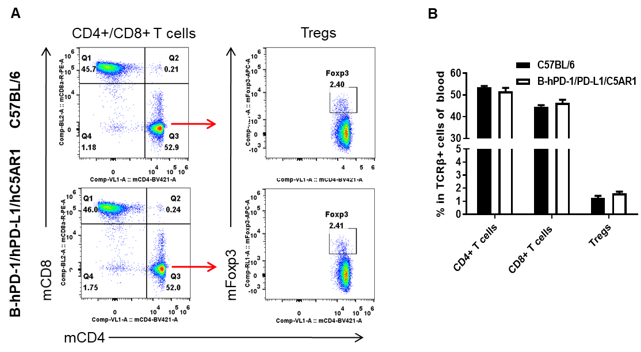
Analysis of blood T cell subpopulations by FACS. Blood cells were isolated from female C57BL/6 and B-hPD-1/hPD-L1/hC5AR1 mice (n=3, 6-week-old). Flow cytometry analysis of the blood cells was performed to assess leukocyte subpopulations. A. Representative FACS plots. Single live CD45+ cells were gated for TCRβ+ T cell population and used for further analysis as indicated here. B. Results of FACS analysis. The percent of CD4+ T cells, CD8+ T cells, and Tregs in homozygous B-hPD-1/hPD-L1/hC5AR1 mice were similar to those in the C57BL/6 mice, demonstrating that introduction of hPD-1, PD-L1 and C5AR1 in place of its mouse counterpart does not change the overall development, differentiation or distribution of these T cell subtypes in blood. Values are expressed as mean ± SEM.
Antibody binding assay

Antibody binding analysis of B-hPD-1/hPD-L1/hC5AR1 mice by FACS. Splenocytes were isolated from wild-type C57BL/6 mice (+/+) and homozygous B-hPD-1/hPD-L1/hC5AR1 mice (H/H). Anti-hC5AR1 antibody avdoralimab (in house) can bind CD11b+ cells in spleen of B-hPD-1/hPD-L1/hC5AR1 mice. But the antibody can not bind the cells in spleen of wild-type C57BL/6 mice. Thus the anti-hC5AR1 antibody can specifically bind cells of B-hPD-1/hPD-L1/hC5AR1 mice.
In vivo efficacy of combination of anti-human PD-1 antibody and anti-human C5AR1 antibody
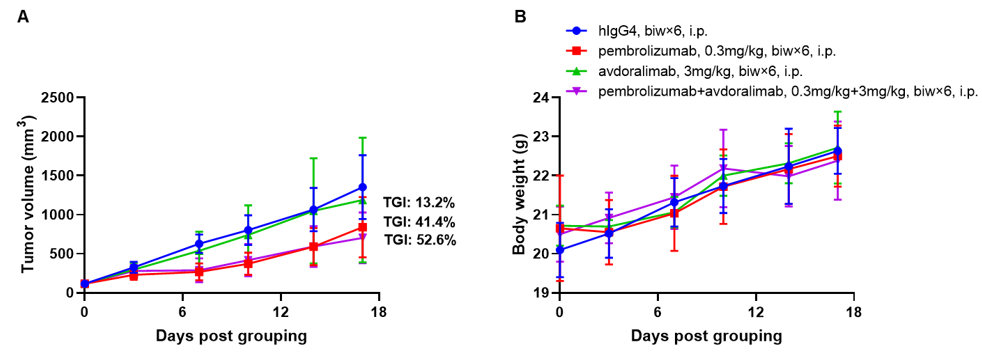
In vivo efficacy of combination of anti-human PD-1 antibody and anti-human C5AR1 antibody
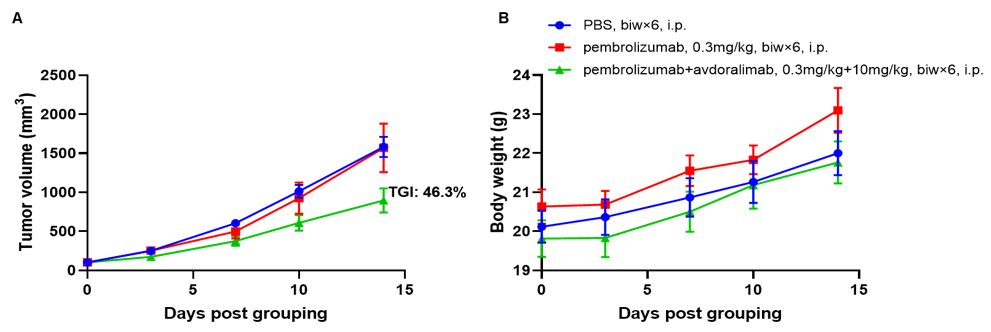
Antitumor activity of combination of anti-human PD-1 antibody (pembrolizumab, in house) and anti-human C5AR1 antibodies (avdoralimab, in house) in B-hPD-1/hPD-L1/hC5AR1 mice. (A) combination of anti-human PD-1 antibody and anti-human C5AR1 antibody inhibited B-hPD-L1 MC38 plus tumor growth in B-hPD-1/hPD-L1/hC5AR1 mice. Murine colon cancer B-hPD-L1 MC38 plus cells were subcutaneously implanted into homozygous B-hPD-1/hPD-L1/hC5AR1 mice (female, 5-8-week-old, n=6). Mice were grouped when tumor volume reached approximately 100 mm3, at which time they were treated with anti-human PD-1 antibody and anti-human C5AR1 antibody with doses and schedules indicated in panel. (B) Body weight changes during treatment. As shown in panel A, combination of anti-human PD-1 antibody and anti-human C5AR1 antibody were efficacious in controlling tumor growth in B-hPD-1/hPD-L1/hC5AR1 mice, demonstrating that the B-hPD-1/hPD-L1/hC5AR1 mice provide a powerful preclinical model for in vivo evaluation of combination of anti-human PD-1 antibody and anti-human C5AR1 antibody. Values are expressed as mean ± SEM.











 京公網安備: 11011502005564號
京公網安備: 11011502005564號